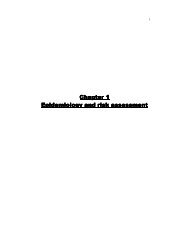Pan Arab Journal of Oncology - Arab Medical Association Against ...
Pan Arab Journal of Oncology - Arab Medical Association Against ...
Pan Arab Journal of Oncology - Arab Medical Association Against ...
You also want an ePaper? Increase the reach of your titles
YUMPU automatically turns print PDFs into web optimized ePapers that Google loves.
Table 1: 3DCRT dose statistics in Gy for PTV & different OARs for postoperative parotid radiotherapy. PTV dose inhomogeneity in percentage is also shown.<br />
Pt No<br />
PTV min<br />
dose<br />
PTV max<br />
dose<br />
Inhomgenity<br />
%<br />
Dose prescribed is 60Gy<br />
Spinal cord<br />
max dose<br />
Brain stem<br />
max dose<br />
contralateral<br />
Parotid<br />
mean dose<br />
Oral cavity<br />
mean dose<br />
Contral.<br />
cochlea mean<br />
dose<br />
Ipsil,<br />
cochlea mean<br />
dose<br />
1 57 67.20 17 16.8 15.6 6 43.8 1.8 8.4<br />
2 57 66.60 16 19.8 21 7.8 30.6 1.2 12.6<br />
3 57 67.20 17 57* 41.4 8.4 51.6 2.4 7.2<br />
4 57 63 9 18.6 15 7.2 33 1.8 16.8<br />
5 57 66 15 58.2* 14.4 12.6 45 3.6 3<br />
6 57 64.20 12 16.8 18 10.2 15 12 40.8<br />
7 57 67.20 17 36.6 31.8 8.4 31.8 3.6 16.8<br />
8 57 67.20 17 34.8 22.2 10.2 31.2 12.6 27<br />
9 57 67.20 17 40.2 19.2 7.8 54.6 1.8 8.4<br />
10 57.60 64.80 12 23.4 15.6 4.8 27.6 1.2 13.2<br />
Min 57 63 10 16.8 14.4 4.8 15 1.2 3<br />
Max 57.60 67.20 16 58.2 41.4 12.6 54.6 12.6 40.8<br />
Average 57 66 15 32 21 8 36 4 15<br />
*Patients number 3 &5 were treated with lower doses to avoid the very high dose to the spinal cord where the prescribed dose was reduced to 50Gy (the spinal cord<br />
dose was 47.5 and 48.5 respectively)<br />
Discussion<br />
Post-operative radiotherapy to the parotid bed is an integral part <strong>of</strong> the<br />
optimum management <strong>of</strong> parotid gland carcinoma. Although it reduces local<br />
recurrence rate, radiation to the organs adherent to the surgical bed or in the<br />
exit <strong>of</strong> the irradiating beams may cause serious long standing problems (5) . So,<br />
optimum radiotherapy technique should ensure good target coverage and dose<br />
conformity while maintaining the dose to OARs within their tolerance levels.<br />
This can be achieved by adjusting beam direction and other beam parameters<br />
(as done in the present study) by using two ipsilateral wedged oblique and direct<br />
lateral fields.<br />
Regarding PTV dose coverage; in our study, the average <strong>of</strong> minimum dose to<br />
PTV was 57 Gy (95%) and the average <strong>of</strong> maximum dose was 66 Gy (110%).<br />
Nutting et al (5) in his study comparing different radiotherapy techniques to the<br />
parotid gland found that (when using 3DCRT), the min dose to the PTV was<br />
55Gy (91%) and the maximum dose was 62.8 Gy (105%). Also he found that the<br />
percentage <strong>of</strong> the dose inhomogeneity was 13% compared to 15% in our work.<br />
The dose heterogeneity within PTV in the study done by Yirmibesoglu et al (12)<br />
was greater and unaccepted with the use <strong>of</strong> wedged pair (about 30%), compared<br />
to 15% with 4 fields IMRT and 11% with 7 fields IMRT.<br />
In spite <strong>of</strong> the higher radiation dose to the oral cavity and the contralateral<br />
parotid gland in our study, our results were still below the tolerance dose that<br />
causes xerostomia, which was determined by Eisbruch et al (13, 14) to be 24-26<br />
Gy to the contralateral parotid gland, and it agrees with G Studer et al (7) , who<br />
concluded that a mean dose <strong>of</strong> 35 Gy is enough to spare oral mucosa.<br />
The mean dose to ipsilateral & contralateral cochlea in the present study, were<br />
15Gy & 4Gy respectively. Both values were under the threshold to cause<br />
sensorineural hearing loss which ranges between 30 and 70 Gy (15,16) .<br />
Nutting et al (5) who carried out 3DCRT plan using two wedged ipsilateral oblique<br />
fields to irradiate the parotid, reported the mean dose to the cochlea to be 42.3Gy,<br />
which is much higher than we achieved. The mean dose <strong>of</strong> cotnralateral cochlea<br />
in the study done by Yirmibesoglu et al (12) was 4.8 Gy, 22.5 Gy & 1.6 Gy for 2<br />
wedged technique, 7 & 4 fields IMRT respectively.<br />
In the present work the maximum point dose to the brain stem was 21 Gy<br />
compared to 27.4Gy in the study done by Nutting et al (5) .<br />
The doses to the brain stem and cochlea achieved in our study were even better<br />
than doses achieved by IMRT in the study done by Nutting et al (5) .<br />
In the present work, the average <strong>of</strong> the mean dose to oral cavity was 36Gy,<br />
which is much higher than the mean dose to the oral cavity in the study done by<br />
Nutting et al (5)<br />
Also in our study, the mean dose to contralateral parotid was 8 Gy compared to<br />
1.6±0.7 in the study done by Nutting et al. Eda Yirmibesoglu et al (12) compared<br />
2 wedged technique with 7 & 4 fields IMRT and achieved a mean dose to<br />
contralateral parotid <strong>of</strong> 2.4 Gy, 18.6 Gy & 1.1 Gy.<br />
So, although we achieved higher dose to oral cavity and contralateral parotids<br />
(compared to other 3DCRT techniques) because we used lateral direct photon<br />
field, our values still less than the tolerance values <strong>of</strong> these organs, with better<br />
doses to the brain stem, ipsilateral and contralateral cochlea and without<br />
compromise the homogeneity and the conformity <strong>of</strong> the PTV.<br />
www.amaac.org <strong>Pan</strong> <strong>Arab</strong> <strong>Journal</strong> <strong>of</strong> <strong>Oncology</strong> | vol 5; issue 3 | September 2012 < 29









